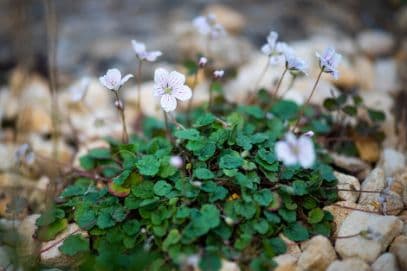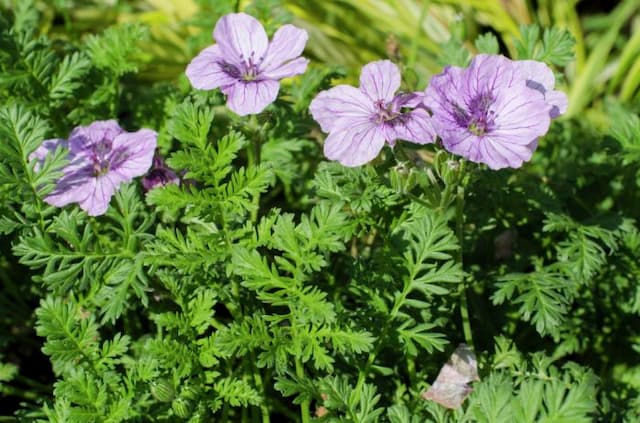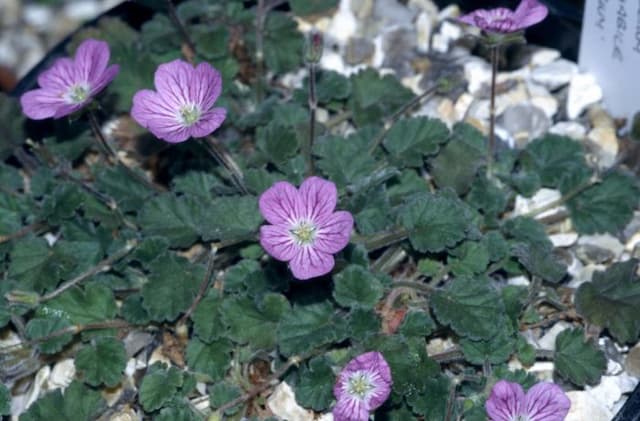Himalayan Cranesbill Geranium wallichianum 'Sylvia's Surprise' (PBR)

ABOUT
Geranium wallichianum 'Sylvia's Surprise' is a charming flowering plant frequently found in home gardens and landscapes, appreciated for its ornamental appeal. The plant sports lush, rounded leaves with deep lobes, presenting a dense and attractive groundcover that exudes a sense of vitality. The foliage often displays a rich green color, providing a perfect backdrop for the flowers. The blossoms are the star attraction of this plant. 'Sylvia's Surprise' typically produces beautiful flowers that can vary in shades from pale to vivid pinks, often marked with striking patterns of veins or darker colorations at the base of the petals. These flowers generally have a rounded shape, with five distinct petals that spread open to welcome pollinators. Adding to its visual splendor, the plant has a generous blooming period, with the flowers emerging from late spring and continuing to bring color to the garden throughout the summer months. The overall appearance of Geranium wallichianum 'Sylvia's Surprise' is one of a robust, floriferous plant that provides delightful color and texture to garden settings.
About this plant
 Names
NamesSynonyms
Wallich's Cranesbill, Himalayan Geranium.
Common names
Geranium wallichianum 'Sylvia's Surprise' (PBR)
 Toxicity
ToxicityTo humans
Geraniums, like Geranium wallichianum 'Sylvia's Surprise', are generally considered non-toxic to humans. There is no major concern for human health if ingested, as they are not known to contain any toxic principles that would cause serious poisoning symptoms. However, it is still advisable to avoid eating any part of ornamental plants due to potential digestive discomfort or allergic reactions that some individuals may experience.
To pets
Geraniums, including Geranium wallichianum 'Sylvia's Surprise', can be toxic to pets if ingested. They contain geraniol and linalool, which are toxic to certain pets, such as cats and dogs. Symptoms of geranium poisoning in pets can include vomiting, diarrhea, depression, anorexia, and dermatitis. In severe cases, ingestion can potentially lead to more serious conditions like hypotension or hyperthermia. It's important to keep these plants out of reach of pets and seek veterinary care if you suspect your pet has ingested any part of the plant.
 Characteristics
CharacteristicsLife cycle
Perennials
Foliage type
Deciduous
Color of leaves
Green
Flower color
Pink
Height
1-1.5 feet (30-45 cm)
Spread
1-1.5 feet (30-45 cm)
Plant type
Herb
Hardiness zones
5
Native area
Himalayas
Benefits
 General Benefits
General Benefits- Aesthetic Appeal: Geranium wallichianum 'Sylvia's Surprise' boasts vibrant pink-purple flowers with striking dark veins and a white center, adding a splash of color to gardens.
- Attracts Pollinators: The flowers provide nectar for bees, butterflies, and other pollinating insects, promoting biodiversity.
- Low Maintenance: It is known for being easy to care for, requiring minimal upkeep once established.
- Drought Tolerance: Once established, it can tolerate periods of dry conditions, making it suitable for water-wise gardens.
- Rapid Growth: This plant often has a quick growth rate, allowing for a swift garden fill and fast landscape transformation.
- Long Blooming Period: It has a prolonged flowering season, often from spring to fall, providing a long-lasting display of blooms.
- Versatile Use: Suitable for borders, beds, and containers, this geranium is adaptable to various garden designs.
- Disease Resistance: It is generally resistant to common garden pests and diseases, reducing the need for chemical treatments.
- Cold Hardy: It can withstand cooler temperatures, making it a good choice for gardens in temperate climates.
- Herbaceous Perennial: As a perennial, it comes back year after year, providing a lasting presence in the garden.
 Medical Properties
Medical PropertiesThis plant is not used for medical purposes.
 Air-purifying Qualities
Air-purifying QualitiesThis plant is not specifically known for air purifying qualities.
 Other Uses
Other Uses- Artistic inspiration: The striking bloom of the Geranium can serve as a muse for artists and photographers, inspiring a range of artworks, from detailed botanical illustrations to abstract interpretations.
- Natural dye: The petals can be used to create a natural dye for fabrics, yielding shades of blue and purple, depending on the mordant used.
- Educational tool: Horticulturalists and educators may use the Geranium in lessons or workshops about plant propagation, as it can be easily propagated from cuttings.
- Garden photography: The Geranium's unique appearance makes it an excellent subject for garden photography enthusiasts, helping them practice close-up shots and depth of field control.
- Living mulch: When planted densely, Geranium groundcovers can act as a living mulch, retaining soil moisture and suppressing weed growth.
- Ecological studies: This plant can be used in ecological studies to understand the interactions between different plant species and their pollinators.
- Theme gardens: Geraniums can be used in thematic garden displays, such as Victorian or cottage gardens, to add authenticity and aesthetic appeal.
- Companion planting: As a companion plant, Geraniums can be beneficial for vegetable gardens by attracting beneficial insects or repelling pests.
- Floral arrangements: Fresh or dried Geranium flowers can be used in floral arrangements, wreaths, or potpourris for their color and texture.
- Culinary decoration: While not commonly consumed, the petals can be used as an edible decoration for desserts and salads, providing a splash of natural color.
Interesting Facts
 Feng Shui
Feng ShuiThe Geranium is not used in Feng Shui practice.
 Zodiac Sign Compitability
Zodiac Sign CompitabilityThe Geranium is not used in astrology practice.
 Plant Symbolism
Plant Symbolism- Healing: Many geranium species are known for their healing properties and are used in traditional medicine. 'Sylvia's Surprise' may carry this symbolism, representing health and recovery.
- Friendship: Geraniums are often associated with friendship, making them a suitable gift for a friend or loved one to show affection and deep connection.
- Peace: The soothing appearance of the geranium can symbolize peace and tranquility, offering a sense of calm to those who gaze upon it.
- Positive Energy: With its vibrant colors and lush foliage, this plant is often thought to bring positive energy into a space, symbolizing happiness and vitality.
 Water
WaterThe Himalayan Geranium should be watered thoroughly, allowing the soil to dry out slightly between waterings. Water the plant with approximately 1 gallon of water every week during the growing season, adjusting the amount depending on the weather and soil drainage. In hot, dry periods, you may need to water more frequently to maintain consistent soil moisture. During winter, reduce watering to every other week or less, depending on indoor conditions and the plant's reduced growth rate. Always use a gentle watering method to avoid disturbing the soil or damaging the leaves and flowers.
 Light
LightThe Himalayan Geranium thrives best in full sun to partial shade. It should be placed in a location where it can receive at least 4 to 6 hours of sunlight each day. Avoid excessively hot and sunny spots, as this can stress the plant. Dappled shade during the hottest part of the day is ideal for keeping the flowers vibrant and the foliage healthy.
 Temperature
TemperatureHimalayan Geraniums perform well in a wide range of temperatures but prefer to stay within the range of 60°F to 75°F. They can tolerate brief periods of colder weather down to about 30°F, but frost can damage the plant. Avoid exposure to extreme heat above 85°F, which can lead to stress and wilting. The ideal temperature conditions allow for healthy growth and flower production throughout the growing season.
 Pruning
PruningPrune the Himalayan Geranium to maintain its shape, encourage bushier growth, and remove spent flowers to prolong blooming. Pruning should be done in early spring or after the first flush of flowers. Cut back the stem by about one-third, focusing on old or leggy growth. Additionally, light pruning can be done throughout the growing season to remove dead leaves and flowers.
 Cleaning
CleaningAs needed
 Soil
SoilHimalayan Cranesbill, also known as Geranium wallichianum 'Sylvia's Surprise', thrives in well-draining soil enriched with organic matter. The ideal soil mixture would include equal parts of garden soil, peat moss or compost, and perlite or sand to ensure proper drainage. The optimal pH range for this plant is between 5.8 and 6.3, slightly acidic to neutral.
 Repotting
RepottingHimalayan Cranesbill should be repotted every 2 to 3 years to refresh the soil and allow room for growth. It's best to repot in spring before active growth begins. Ensure the new pot is only slightly larger than the previous one to prevent waterlogging.
 Humidity & Misting
Humidity & MistingHimalayan Cranesbill does not require high humidity and can tolerate the average humidity levels found in most homes. However, it benefits from a moderate humidity level, around 40-50%, which mimics its native mountainous habitats.
 Suitable locations
Suitable locationsIndoor
Place in bright indirect light, keep soil moist.
Outdoor
Plant in part shade; water when topsoil is dry.
Hardiness zone
5-9 USDA
 Life cycle
Life cycleGeranium wallichianum 'Sylvia's Surprise', commonly known as cranesbill, begins its life cycle as a seed which germinates in favorable conditions of moisture and temperature. The seedling emerges, developing roots and cotyledons before true leaves appear, marking the vegetative growth stage. As the plant matures, it forms a distinctive mound of deeply cut foliage, entering a period of vegetative stability and robust health. Flowering occurs in late spring to summer, when the plant produces its characteristic five-petaled flowers that attract pollinators. After pollination, seeds develop and are eventually dispersed to begin the next generation. During the colder months, the cranesbill may die back, entering a phase of dormancy, only to re-emerge and repeat its life cycle with the return of warmer weather.
 Propogation
PropogationPropogation time
Spring-Early Summer
The Geranium wallichianum 'Sylvia's Surprise' is commonly propagated through the division method, which is best done in spring or fall. To use this method, you should carefully lift the plant from the ground, ensuring you get a good portion of the root system. Using a sharp, sterilized knife or spade, split the plant into smaller sections, each with its fair share of roots and shoots. Replant these divisions immediately into a well-prepared soil that is rich in organic matter and ensure they are watered thoroughly. This technique allows the plant to recover from the shock of division during the cooler, wetter conditions of spring and fall, encouraging healthy growth as the temperatures rise or before the plant goes into dormancy for winter.




![Cranesbill [Blue Sunrise]](/_next/image?url=https%3A%2F%2Fplants-admin.emdemapps.com%2Fimages%2Fplants%2F%2Fimages%2F604b638d45948.png&w=640&q=75)




